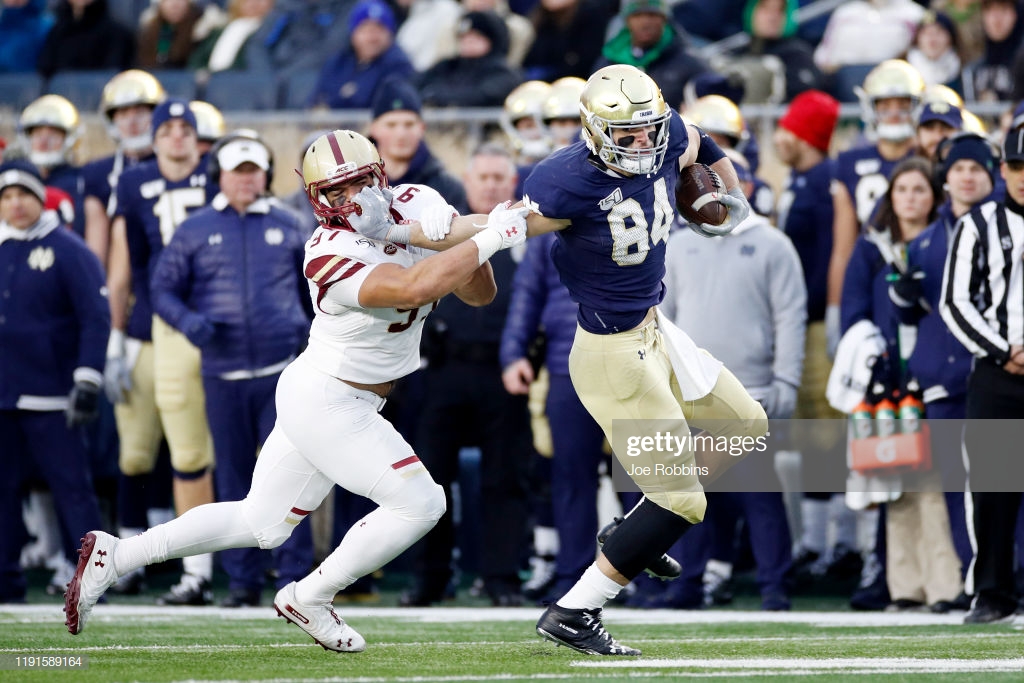This isn’t going to be the cheeriest article. Alas.
We began the draft process saying two things. First, tight end was the closest thing to a need on Pittsburgh’s roster; and second, that wasn’t good news because the 2020 TE class looked historically bad. A number of prospects seemed to offer developmental traits worthy of a Day 3 draft pick, but even the best would not begin to offer value until Round 3, let alone at the mid-2nd pick held by Pittsburgh.
Hopes crept up a bit as the process inched forward. Junior Cole Kmet declared early, and immediately became the top prospect on the board. Bryce Hopkins displayed a better attitude (in interviews) toward blocking than his film suggested, and we were constantly reassured that he couldn’t be as bad as he looked because his father had been a pro bowl offensive lineman. Adam Trautman appeared out of the small school mist to give us a new name, and then looked like a peer of the big boys at the Senior Bowl. A few other prospects revealed some glimmers of hope too. Maybe one of these could test well enough to be worth serious consideration at #47 overall?
Then came the Combine. Alas. Because it basically reinforced the initial conclusion. Developmental traits abound but there are no complete packages from the athletic point of view.
- Kmet has much better than expected size and really looks the part, but he really is “just” a good athlete on the NFL scale and nothing worth writing home about.
- Albert Okwuegbunam ran like the wind in a straight line, but we almost expected that from his film. The issue there is that he blocked (in college) like the wind too.
- Trautman looks good but his traits aren’t special enough to raise any eyebrows, and the small school stigma exists for a reason.
- Harrison Bryant has T-rex arms.
- None of the good blockers turned out to have startling athletic skills.
- Etc.
The class may not be historically bad, but it certainly isn’t good. There are maybe eight to ten prospects who should, with coaching, develop into legitimate TE2’s. Two to five of those might somehow grow into TE1 status. But none of them project as special talents, and all of them project as 3-4 year projects.
We fans need to focus most of all on that time frame.
Everyone knows that TE’s tend to develop slowly in any event. That is a problem inherent in the position, because TE’s are asked to do so many things. Consider the benefits offered by a superior TE1. He tilts the field because he is a mismatch on every play. Try to cover a guy like George Kittle with a Linebacker or a Safety big enough to counter his strength, and Kittle will catch passes all day long. Especially in crucial 3rd-down situations. Assign a coverage-oriented Safety or a big Corner toward Kittle, and he will block the poor slob into next week, leaving truck-sized holes for his running backs. Catch 22. Premier TE’s make every defensive alignment wrong in some way or the other.
The flip side is that poor TE’s make every defensive move seem stronger. Players like Pittsburgh’s own Terrell Edmunds, Mark Barron, and Devin Bush get draft projections like “TE eraser” because they are big enough to stay in the game on running plays, fast enough to blanket average opponents in coverage, and athletic enough to make plays no matter how the TE tries to prevent it. The mismatch issue can run in both directions!
All three of those positions (TE, ILB, and Safety) take extra time to develop precisely because they have so many disparate duties to learn. For whatever reason, TE’s tend to mature slowest of all. Even the best prospects, like last year’s TE T.J. Hockenson, tend to disappear in their rookie seasons. They start to contribute in Year 2, hit their stride in Years 3-4, and hit their peaks in years 5-10. If I may be permitted to stereotype badly and to merge individuals into a mass, average TE prospect typically take a year longer and develop to a lower ceiling. That projection is the basis for how nerds like me will grade them on Big Boards. The long development time also explains why Tight Ends have traditionally been undervalued compared to many other positions.
This year’s group is not going to produce any rookie-year contributors. That much is clear. Nor, subject to the exception who proves the rule, any players who will help their team significantly in the 2021/22 season. The best of them are likely to mature into starters for 2022 and onwards, with none of them maturing into Kittlesque, field tilting stars.
Are you a Pittsburgh Steelers fan who has every voiced a concern about “Big Ben’s window?” If so, throw any dreams of a TE pick out the window for the 2020 draft. None of these prospects will really help this team before Roethlisberger’s contract is up. All bets are off if he pulls a Brady and continues to play at a high level into his 40’s, but if that’s the case then your window wasn’t exactly closing to begin with.
Does that mean I want to remove TE’s from the Steelers Big Board? Far from it! I do not believe in windows, and certainly not in windows that can be filled with draft picks! The draft exists to build our team for the long haul, and Tight Ends are an important part of that puzzle. I am just saying that the draft isn’t going to offer any TE who will help in the short term. Only a trade or a free agent signing could help for a short term push.
My concern is simpler and more self serving. How should these prospects be graded on the Board I write for this site? What is the value of a good but not great TE prospect? One who projects as a likely TE2 from his third year on, but could end up being a little better than that? In most years the answer would be a “highest value” in the late 3rd round, with bargain steals beginning in Round 5. Anywhere from HV 3:24 to 5:01 using the grading system of our Steelers Big Board and accounting for individual variations.
Question: who in this class do we still believe should grade out any higher? And why do we believe it? That is the debate I think we ought to have in these Comments. For what it’s worth, I would personally give a slight bump to a few prospects who I believe have the upside to become solid-but-not-special TE1’s. Who? We can get to that in the Comments, because I have to acknowledge that my preferences are a matter of taste rather than analysis. What I will say is this: I do not believe that even my favorites are likely to contribute any faster, just that their ceilings are a wee bit higher, and the “bump” is up to a late-2nd or early-3rd grade that would still be a lamentable reach for the pick at #47 overall.
Alas.








